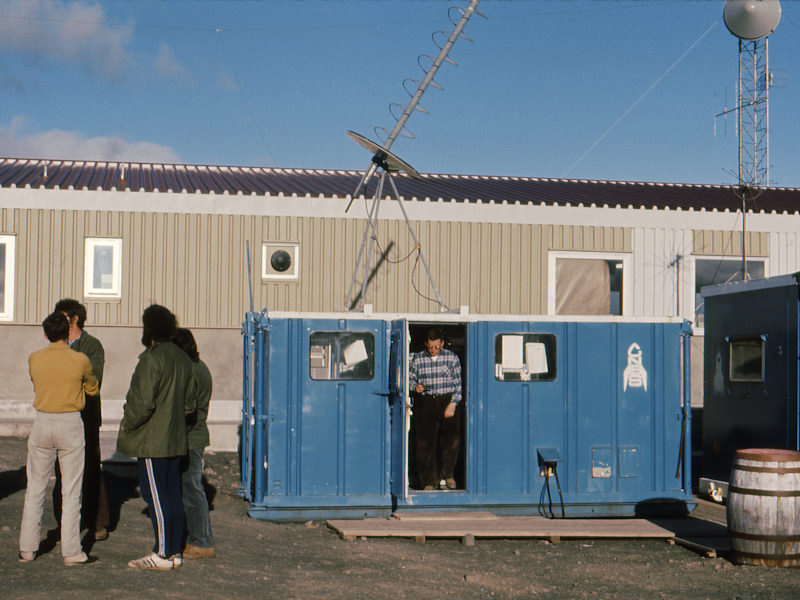Photo
album: "ARAKS: First launch"
Fly
over a photo with the mouse to enlarge it
Click
on a photo to open it in a new window
Visit
of the base of the National Centre for Space Studies (CNRS) from where the
rockets will be launched. We are waiting since January 13rd for
favourable conditions to the first launch of the ARAKS experiment. Meanwhile we
take advantage to visit the ground equipments of CNES and GRI. On January 26th
these conditions are at last met and two American ARCAS rockets will be launched
followed by a French Eridan rocket. All the equipments on board the rockets have
worked normally as has been confirmed by a first check of the data registered at
ground.
 |
Let us go now to the base of Centre
National d'Etudes Spatiales, from where the rockets will be launched. |
 |
These two tubes permit to launch
small American ARCAS rockets. These rockets are destined to make X-ray
measurement in the upper atmosphere. Two ARCAS rockets will be launched
before each Eridan rocket launch.
|
 |
This is the mobile shelter which
protects the Eridan rocket launching ramp. The names of the two space
agencies participating in this experiment are printed on its side: CNES (with
the French flag) and INTERCOSMOS (with the Soviet flag). |
 |
Moving the shelter, on rails,
allows to uncover the launching ramp with the Eridan rocket hanging under
it.
|
 |
We can see here: the ejectable
nose cone which encloses the magnetic and electric French sensors as well
as the Soviet SPECTRE experiment; the second stage of the Eridan rockets
which contains, in addition to the propulsion part, the Soviet electron
gun and different French and Soviet sensors. |
 |
The launching ramp is setting
upright, this permits to see the two stages of the Eridan rocket. |
 |
The rocket is now in launching
position: it is no longer hanging under the ramp but it is above and
pointing to the sky. |
 |
Since January 13rd,
every night, all the team is on the alert from 2 am. to 9 or 10 am.,
because they are waiting for the favourable conditions for the launch.
Those conditions are difficult to meet and, already, in December it was
not possible to meet them. Amongst those conditions, the weather have to
be fine at both extremities of the magnetic lines. Particularly, above
USSR where clouds would prevent from observing the aurora created by the
arrival of the electrons emitted by the Eridan rocket. |
 |
The antenna on the roof of the
CNES shelter is a backup antenna, ready to take over in case of failure of
the main receiving antenna. |
 |
Inside the CNES shelter, the
watching team is ready and plays cards to kill time. |
 |
The different data receiving and
recording equipments inside the CNES shelter. |
 |
In Géophy laboratory, Bernard
Morlet is monitoring the different geophysical parameters measured at the
ground. |
 |
The cabinets containing the
acquisition systems for the geophysical data measured at ground, in
Géophy laboratory. |
 |
In Géophy laboratory, the magnetic recorders are ready to acquire the
ground parameters during the flight of the Eridan rocket. |
 |
The CNES main receiving antenna is
pointed and ready to follow the Eridan rocket during its flight in order
to receive the signals registered by the onboard experiments. |
 |
The Soviet radar will permit to
follow the trajectory of the Eridan rocket which will get up to an
altitude of roughly 20 km. |
 |
On January 26th 1975,
the different conditions for a launch are at last met. Eleven minutes
before launching the Eridan rocket, a first ARCAS rocket has just been
launched. A second ARCAS rocket will be launched a few seconds before the
departure of the Eridan rocket. |
 |
In Géophy laboratory, the ARAKS
team check the correct recording of the start chronology of the
experiments on board the Eridan rocket. |
 |
The Eridan rocket is taking off. |
 |
The launch area is flooded with
smoke, just after the takeoff. |
 |
A few seconds later, the first
stage after having exhausted its fuel uncouples and falls down. The
combustion of the second stage begins. |
 |
The Soviet scientist responsible
for the SPECTRE experiment on board the nose cone, checks its proper
functioning. |
 |
The ARAKS team from GRI watches
the first graphical checkup recordings. |
 |
In Géophy laboratory, all the
ground geophysics sensors have worked normally. |
 |
The useful flight duration is 7
minutes only. During this time, a great number of data were recorded.
Since everything seems to have worked perfectly, all the participants
gather in the Géophy bar to feast the excellent exit of this first launch. |
 |
The French cineaste clears himself
a path in the middle of the ARAKS teams whilst the boom operator proceeds
in recording the different comments. |
 |
Jacques Lavergnat (GRI), scientific
manager of the ARAKS experiment (left) and Gilles Charles manager of the
CNES team (right), exchange their feelings after this first launch. |
Go
back
.
.
.
.
.
.
.





















